IER News & blogs
Maximising productivity through managing new technology
Research on the relationship between new technology and productivity has just been published by The Productivity Institute. The study concluded that management skills (core and technology related) are required to maximise the returns of new technology investments. Those companies that had a strategic approach to technology investments and management development implemented their investments more effectively. Currently, management training in the West Midlands is not configured to support businesses to effectively implement new technology, and companies rely on technology suppliers.
What are the implications of COVID-19 for Coventry and Warwickshire? Dr David Owen
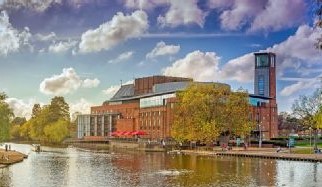 The UK, like most other countries, introduced a “lockdown” in late March in order to reduce contact between people thereby reducing infections and “taking pressure off” the National Health Service. This involved preventing most businesses involving social contact to stop operating and for workers to work from home wherever possible. The implication was a huge cut in economic activity. The National Institute for Economic and Social Research made estimates of considerable economic recession. The Bank of England’s view (on May 7th) of the probable impact of the lockdown is that the UK economy will shrink by 14% in 2020 but rebound quickly, with growth of 15% in 2021.
The UK, like most other countries, introduced a “lockdown” in late March in order to reduce contact between people thereby reducing infections and “taking pressure off” the National Health Service. This involved preventing most businesses involving social contact to stop operating and for workers to work from home wherever possible. The implication was a huge cut in economic activity. The National Institute for Economic and Social Research made estimates of considerable economic recession. The Bank of England’s view (on May 7th) of the probable impact of the lockdown is that the UK economy will shrink by 14% in 2020 but rebound quickly, with growth of 15% in 2021.
This blog presents tentative estimates of the possible impact of the lockdown on employment and enterprises within the Coventry and Warwickshire local enterprise partnership (LEP) area and for small areas within Coventry and Warwickshire.
The Centre for Progressive Policy (CPP) estimated the impact of the lockdown at the local authority scale, drawing upon estimates from the Office for Budget Responsibility (OBR). They estimate the decline in economic output to be nearly 50% in parts of the Midlands and the North West in the second quarter of this year. Their estimates of percentage decline in output (GVA) for the neighbouring area are presented in the Figure 1. Loss of output is largest in Stratford-on-Avon (46.2%), North Warwickshire and Rugby (both 45%), and lower in Coventry (36.7%), Nuneaton (35.6%) and Warwick (34.1%).
Figure 1: CPP estimates of GVA decline by local authority district
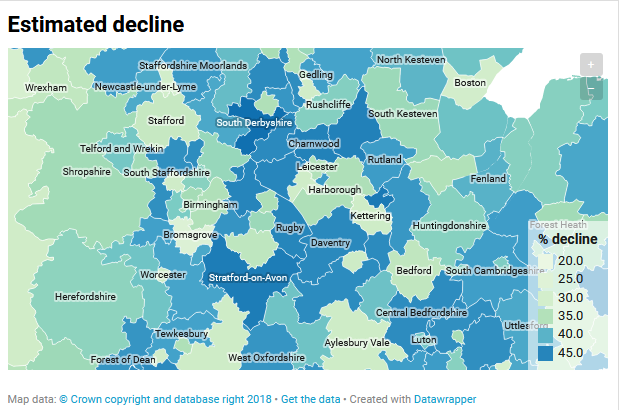
Source: Centre for Progressive Policy
Using the results from Wave 3 of the Office for National Statistics (ONS) Business Impact of Coronavirus (COVID-19) for the period 6 April to 19 April 2020 crude estimates of the possible impact of the lockdown for the LEP area as a whole and for areas within it are provided . This survey revealed that 23% of the businesses which responded had temporarily closed or paused trading, while 23.4% had experienced a loss of turnover of over 50% with a further 20.4% experiencing a loss of turnover of between 20% and 50%. These percentages are reported for the SIC 2007 industry sections in which the response rate was high enough to report.
Here, these estimates are applied to UK Business Counts for the LEP area and the constituent local authority districts and Middle Layer Super Output Areas within it to present tentative estimates of the impact of the lockdown and its geographical variation. Figure 2 presents the distribution of businesses (local units) by industry section in 2019 and the estimated number not trading within the LEP. The estimated numbers not trading are highest for accommodation and food service activities and wholesale and retail trade. The impact of closures is greatest upon arts, entertainment and recreation.
Figure 2: Industrial breakdown of businesses in 2019 and estimated number of businesses not trading
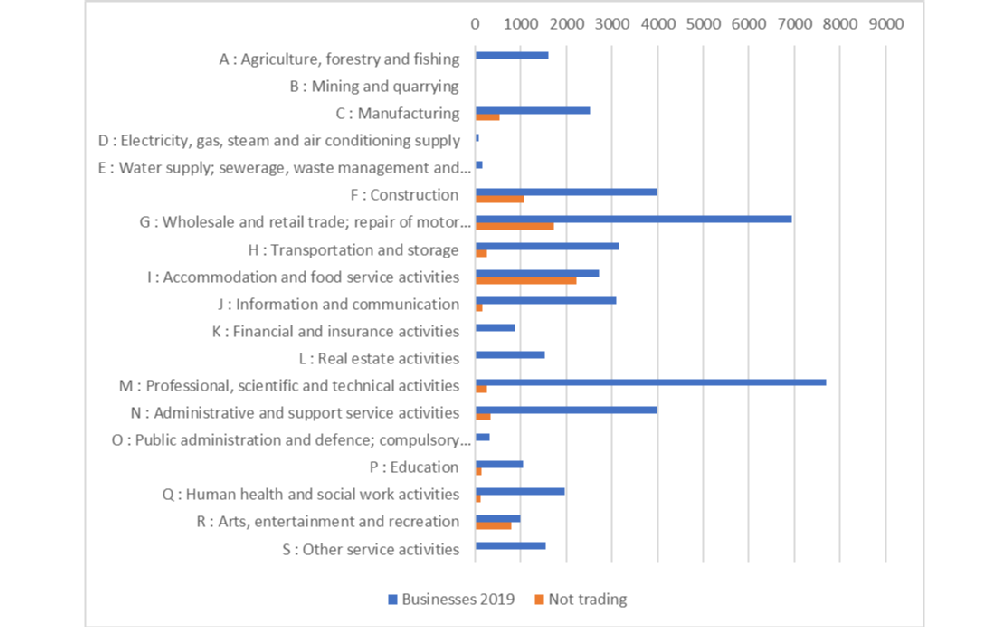
Source: UK Business Counts and IER estimates
Applying the proportion of businesses not trading to the count of businesses in each section yields the results presented in Table 1 for the Coventry and Warwickshire LEP and the six local authorities within it: The estimated percentage of businesses not trading is highest in North Warwickshire and lowest in Rugby and Warwick.
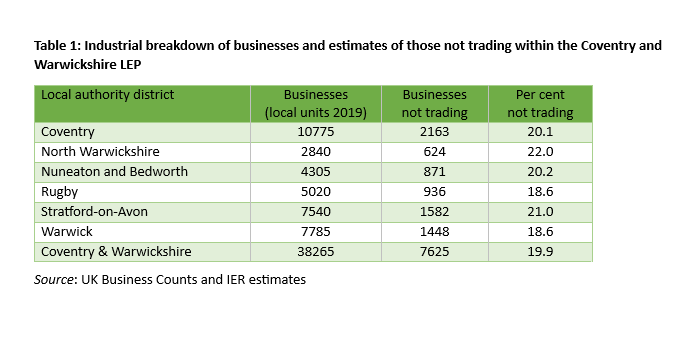
Figure 3 presents the geographical distribution of businesses not trading as a percentage of businesses present in 2019 (for those industries for which ONS reports this percentage). There are marked spatial variations, with higher percentages in the centre and north-east of Coventry, central Rugby, the centre of Stratford-upon-Avon, and Nuneaton. There are also high percentages in more peripheral locations, e.g. southern Stratford-on-Avon district. These are probably areas in which manufacturing plants are located. In contrast, the towns of Warwick district display lower percentages of businesses not trading.
Figure 3: Estimated percentage of businesses not trading within the Coventry and Warwickshire LEP area
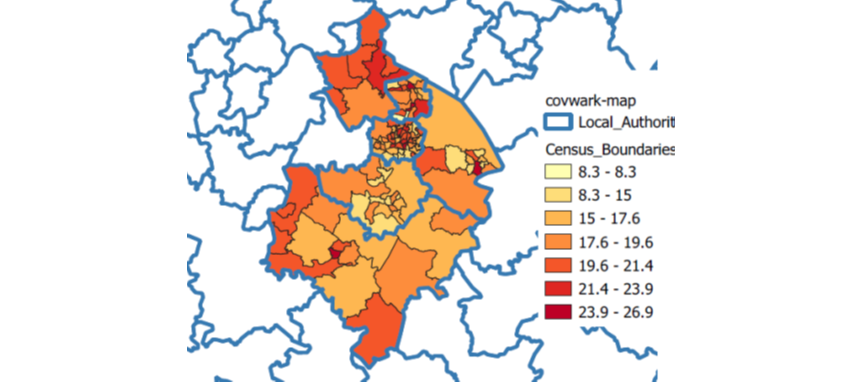
Source: UK Business Counts and IER estimates
Please bear in mind that the estimates presented here are based on a very simple methodology and do not incorporate any factors specific to the local economy. Like the CPP estimates, they provide indicators of the potential geographical pattern of vulnerability to recession, deriving from the industrial structure of localities.
Dr David Owen comments on the UK monthly unemployment figures
 The UK unemployment rate for 16-64 year olds increased very slightly over the last 3 months (November to February compared with August to October 2017), but this was composed of a small fall for men and a slightly larger increase for women. For the West Midlands, the unemployment rate fell very slightly for both men and women over this period, but the fall was larger for men than for women.
The UK unemployment rate for 16-64 year olds increased very slightly over the last 3 months (November to February compared with August to October 2017), but this was composed of a small fall for men and a slightly larger increase for women. For the West Midlands, the unemployment rate fell very slightly for both men and women over this period, but the fall was larger for men than for women.
In the UK as a whole, the percentage of both men and women in the labour force and the percentage of men and women in work increased slightly. However, in the West Midlands, the percentage in work did not change, but the percentage of men in the workforce fell, slightly more than the fall for women. This suggests that the more favourable trend for the West Midlands may be the result of formerly unemployed people (mainly men) no longer looking for work.
At the local scale, unemployment has been increasing sharply (568 more JSA claims in February 2017 than December 2017 - an increase of 20.6%, but only 25 more than 1 February 2017) in Coventry during 2018 (for both men and women), but has fallen in Birmingham (by 783 or 3.6% and by 2.6 thousand or 11.3% 2017-18). However, the unemployment rate for Coventry is 2 per cent, less than half that for Birmingham (4.1 per cent).
Do you work in the hotels, restaurants or fast food outlets industry or in the construction industry in the West Midlands?
If so, we would love to talk to you.
The Institute for Employment Research at the University of Warwick is doing some research for the Home Office on why and how different groups of people work in hotels, restaurants and fast food outlets or in the construction industry in the Greater West Midlands area. The experiences of those working in these two sectors of the economy will be compared and contrasted.
